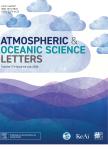Arctic Oscillation Responses to Black Carbon Aerosols Emitted from Major Regions
Arctic Oscillation Responses to Black Carbon Aerosols Emitted from Major Regions作者机构:Nansen-Zhu International Research Centre Institute of Atmospheric Physics Chinese Academy of Sciences University of Chinese Academy of Sciences
出 版 物:《Atmospheric and Oceanic Science Letters》 (大气和海洋科学快报(英文版))
年 卷 期:2015年第8卷第4期
页 面:226-232页
核心收录:
学科分类:07[理学] 070601[理学-气象学] 070602[理学-大气物理学与大气环境] 0706[理学-大气科学]
基 金:jointly supported by the National Basic Research Program of China(973 Program,2015CB453202 and 2012CB417403) the National Natural Science Foundation of China(41421004)
主 题:black carbon Arctic Oscillation linear trend
摘 要:The responses of the Arctic Oscillation(AO) to global black carbon(BC) and BC emitted from major regions were compared using the atmospheric general circulation model Geophysical Fluid Dynamics Laboratory(GFDL) atmospheric general circulation model(AGCM) Atmospheric Model version 2.1(AM2.1). The results indicated that global BC could induce positive-phase AO responses, characterized by negative responses over the polar cap on 500 h Pa height fields, and zonal mean sea level pressure(SLP) decreasing while zonal wind increasing at 60°, with the opposite responses over midlatitudes. The AO indices distribution also shifted towards positive values. East Asian BC had similar impacts to that of global BC, while the responses to European BC were of opposite sign. South Asian BC and North American BC did not affect the AO significantly. Based on a simple linear assumption, we roughly estimated that the global BC emission increase could explain approximately 5% of the observed positive AO trend of +0.32 per decade during 1960 to 2000.



